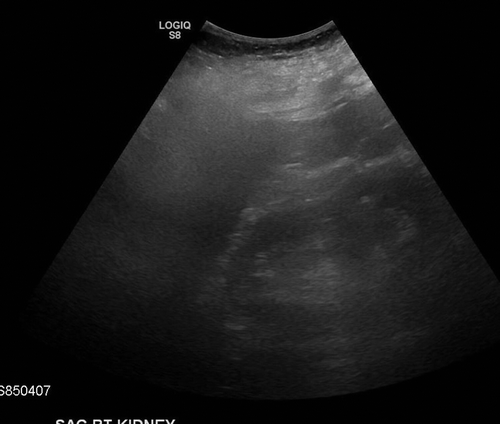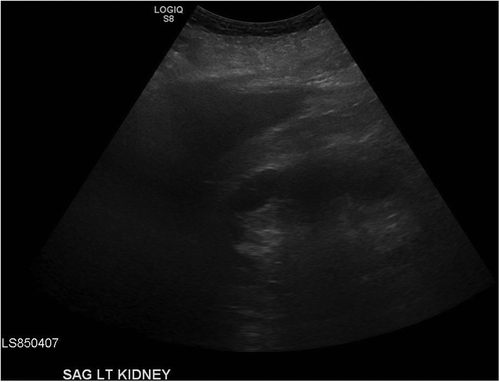ABSTRACT
Hyponatremia is a common finding in patients admitted to hospitals in the USA. There is a plethora of causes ranging from excessive diuretic use to volume overload from underlying heart failure or liver cirrhosis. The consequences of missing or mistreating the aforementioned diagnosis can lead to catastrophic outcomes. Here, we focus on a rare yet overlooked cause of hyponatremia: obstructive nephropathy. The causes of obstructive nephropathy in elderly patients are broad with neurogenic bladder being one of the common ones. Our patient is an elderly male who presented with hyponatremia in setting of urine retention post an orthopedic surgery.
KEYWORDS:
1. Introduction
Hyponatremia (Serum Na: <135) is the most common electrolyte disturbance affecting 15–28% of hospitalized patients [Citation1]. Causes are numerous ranging from excessive diuretic use (sodium loss) to volume overload (heart failure) to pancreatitis. One of the most common causes of hyponatremia is Syndrome of Inappropriate Anti Diuretic Hormone (SIADH). Approximately 33% of all cases of hyponatremia are due to SIADH. SIADH is more common in elderly population due to an exaggerated release of vasopressin in response to serum hyperosmolarity [Citation2]. It is associated with increased risk of falls, osteoporosis, fractures, altered mental status and increased morbidity and mortality [Citation3]. SIADH is a diagnosis of exclusion and most of the time the etiology remains unclear. Some commonly proposed causes are CNS diseases, pulmonary diseases, malignancies and drugs [Citation4]. In this case report, we discuss a patient with urinary retention, post an orthopedic surgery, causing hyponatremia that resolved post foley placement.
2. Case presentation
A 92-year-old gentleman with a past medical history of diabetes, hypertension, CKD stage II, hyperlipidemia, benign prostatic hyperplasia, and recent right hip replacement due to osteoarthritis presented to the emergency department with several days of decreased urine output. Of note, patient is on hydrochlorothiazide at home. He reported he has not been able to urinate post the right hip arthroplasty. Other symptoms included dull, aching, non-radiating lower abdominal pain. Physical exam on presentation was unremarkable except for 1+ bilateral lower extremity pitting edema. The patient was noted to have a distended bladder on the bladder scan. His labs were remarkable for creatinine 6.4 mg/dl, BUN 143 mg/dl, sodium 120, glucose 183, TSH 1.7 uIU/ml, BNP 45 pg/ml, AST 22 u/l, ALT 13 u/l, ALK 67 u/l, total bilirubin 0.5 mg/dl, albumin 2 g/dl. A Foley catheter was placed, and the patient was admitted for further follow-up. Urinalysis was as follows: specific gravity 1.010, Ph 5, protein 30, negative for glucose ketones, leukocyte esterase and nitrites, 10 WBCs and 2 RBCs on microscopic analysis. Urine chemistry was remarkable for urine osmolality 247, urine sodium 48. The calculated fractional excretion of sodium (FeNa) was 6.6%. Renal ultrasound showed unremarkable bilateral kidneys with mildly increased echogenicity as seen in . Echocardiogram showed left ventricular ejection fraction of >75%, hyperdynamic global left ventricular systolic function, and impaired relaxation pattern of LV diastolic filling. The patient’s sodium gradually improved post foley placement and gentle IV hydration. BUN and creatinine started trending downward with appropriate urine output. He was discharged to follow-up as an outpatient.
3. Discussion
Hyponatremia is common in the elderly and can present with changes in cognition, e.g., seizures, coma or respiratory arrest if not treated appropriately and in a timely manner [Citation5]. Changes in plasma sodium concentration usually reflect an excess or deficit of water rather than a change in sodium balance [Citation6]. Hyponatremia is further divided based on volume status as it is treatment specific, namely, hyper, eu or hypovolemic [Citation7,Citation8]. Most cases are in the setting of euvolemia and can be attributed to syndrome of inappropriate release of antidiuretic hormone (SIADH). However, the underlying mechanism of all three subtypes is secretion of arginine vasopressin [Citation6,Citation9].
In elderly patients, hyponatremia is multifactorial. It can be due to age-related loss of nephrons and decrease in GFR, decrease in total body water, diminished thirst mechanism or ‘tea and toast’ diet. These factors cause increased passive reabsorption of water in the distal tubule and thereby impair urinary diluting capacity [Citation7,Citation8]. Medications such as diuretics or antidepressants precipitating SIADH can also play a major role [Citation10]. The diagnostic criteria for SiADH includes clinical euvolemia, serum sodium <135 mEq/L, urine osmolarity >100 mOsmol/kg, serum osmolarity <275 mOsmol/kg, urine sodium >40 mmol/L, and absence of other causes of hyponatremia, e.g., adrenal insufficiency, hypothyroidism, cardiac failure, pituitary insufficiency, renal disease with salt wastage, hepatic disease, and drugs that impair kidney water excretion [Citation11].
Many case studies found an association between hyponatremia and urinary retention in the elderly [Citation12]. It is thought to be related to vasopressin release triggered by bladder wall distension, producing a SIADH like picture. Pain due to bladder distension also plays a role in exacerbating SIADH. Urinary catheterization relieves the obstruction and hence, to some extent, suppresses vasopressin release [Citation6,Citation12]. Furthermore, thiazide use contributes to hyponatremia through natriuresis, reduced free water clearance and directly causing SIADH [Citation13]. Even though our patient was on hydrochlorothiazide, which is a common cause of hyponatremia, he reported urinary retention post the hip procedure, which favors our diagnosis of obstructive-nephropathy-induced hyponatremia. Sodium levels trend upwards towards normal range after Foley catheter placement with appropriate urine output.
4. Conclusions
Hyponatremia in elderly patients is associated with increased morbidity, mortality, hospital stay and cost. There are many causes to hyponatremia. Here, we emphasize a rare yet challenging cause: obstructive nephropathy. If diagnosed early on during hospital presentation, it may result in better patient outcomes and, surely, shorten hospital stay.
Disclosure statement
No potential conflict of interest was reported by the authors.
References
- Hawkins RC. Age and gender as risk factors for hyponatremia and hypernatremia. Clin Chim Acta. 2003;337:169–172.
- Anderson RJ, Chung HM, Kluge R, et al. Hyponatremia: a prospective analysis of its epidemiology and the pathogenetic role of vasopressin. Ann Intern Med. 1985 Feb;102:164–168.
- Emsley RA, Gledhill RF. Thiazides, compulsive water drinking and hyponatraemic encephalopathy. J Neurol Neurosurg Psychiatry. 1984;47:887.
- Thomas CP: Syndrome of inappropriate antidiuretic hormone secretion. Medscape Reference. April 29. 2014.
- Mahajan R, Simon E. Urinary retention as a cause of hyponatremia in an elderly man. Indian J Clin Biochem. 2014;29:29–260.
- MillerM. Hyponatremia and arginine vasopressin dysregulation: mechanisms, clinical consequences, and management. J Am Geriatr Soc. 2006 Feb;54:345–353. PMID: 16460390.
- Ezra N, Alessi CA. Clinical observation: hyponatremia associated with diuretic use and urinary retention in an older man. J Am Geriatr Soc. 2009;57:2353–2354.
- Kugler JP, Hustead T. Hyponatremia and hypernatremia in the elderly. Am Fam Physician. 2000;61:3623–3630.
- Miller M. Syndromes of excess antidiuretic hormone release. Crit Care Clin. 2001;17:11–23.
- Cumming K, Hoyle GE, Hutchison JD, et al. Prevalence, incidence and etiology of hyponatremia in elderly patients with fragility fractures. PLoS One. 2014 Feb;5:88272. PMID: 24505459 PMCID: PMC3914945.
- Rondon-Berrios H, Tandukar S, Mor MK, et al. Urea for the treatment of hyponatremia. Clin J Am Soc Nephrol. 2018 Nov;7:1627–1632. .
- Bartter FC, Schwartz WB. The syndrome of inappropriate secretion of antidiuretic hormone. Am J Med. 1967;42:790–806.
- Galperin I, Friedmann R, Feldman H, et al. Urinary retention: a cause of hyponatremia? Gerontology. 2007;53:121–124. Epub 2006 Nov 17. PMID: 17119339.


